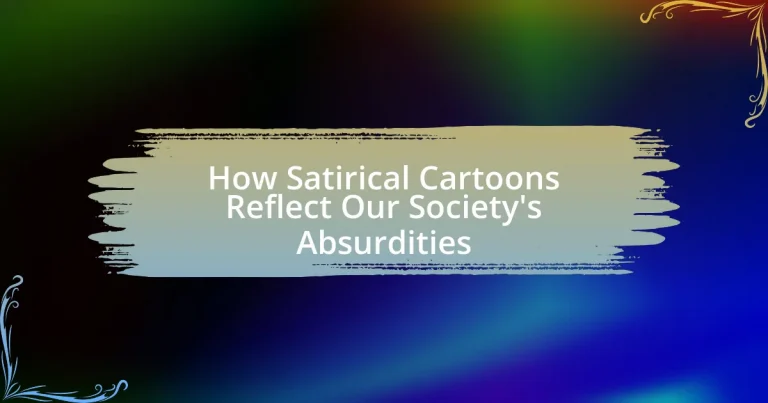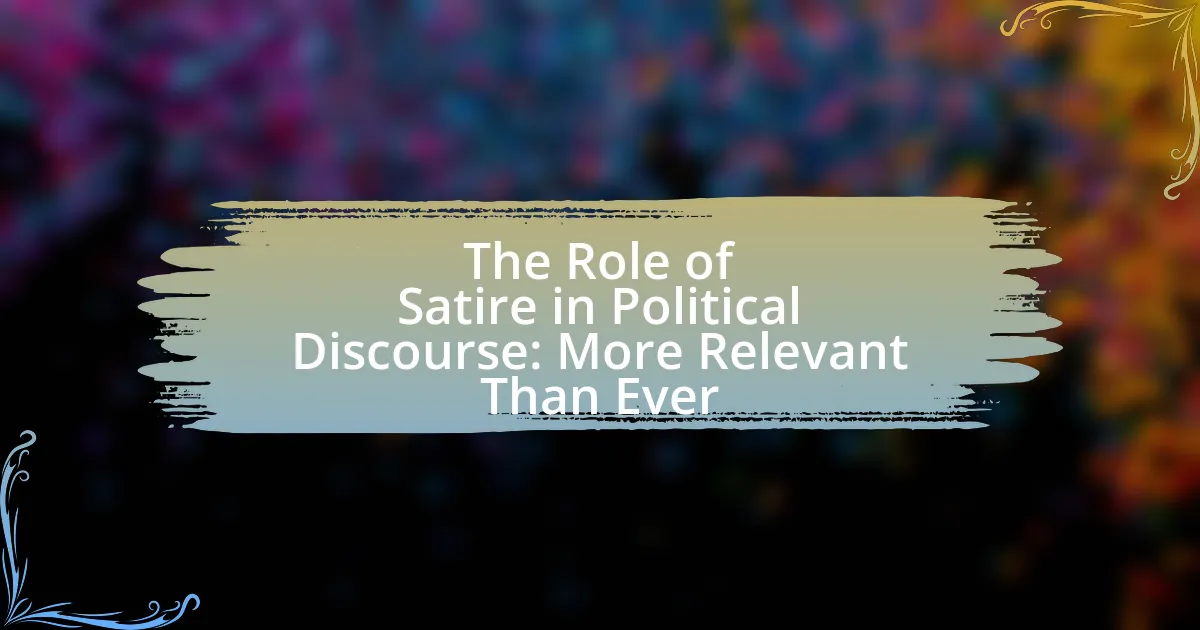Satirical cartoons serve as a powerful medium for reflecting societal absurdities by employing humor, exaggeration, and irony to critique social, political, and cultural issues. These cartoons often depict real-life events and figures in distorted ways, prompting viewers to question the status quo and engage in critical discourse. Key characteristics include the use of visual metaphors and caricatures, which enhance the message of absurdity and make complex topics more accessible. The article explores the evolution of satirical cartoons, their role in political discourse, and the challenges faced by cartoonists today, while highlighting common themes and the emotional responses they evoke in audiences.

How do satirical cartoons reflect societal absurdities?
Satirical cartoons reflect societal absurdities by using humor and exaggeration to critique and highlight the irrationalities present in social, political, and cultural contexts. These cartoons often depict real-life events or figures in a distorted manner, making the absurdity more visible and prompting viewers to question the status quo. For instance, during political elections, satirical cartoons frequently portray candidates in ridiculous scenarios, emphasizing their flaws and the absurdity of their promises, which can lead to increased public awareness and discourse. Historical examples include the political cartoons of Thomas Nast in the 19th century, which exposed corruption in New York City, illustrating how satire can serve as a powerful tool for social commentary and change.
What are the key characteristics of satirical cartoons?
Satirical cartoons are characterized by their use of humor, exaggeration, and irony to critique societal norms, politics, or cultural issues. These cartoons often employ visual metaphors and caricatures to highlight absurdities, making complex topics more accessible and engaging. For instance, the use of exaggerated features in political figures can emphasize their flaws or controversial actions, effectively conveying a message about their behavior. Additionally, satirical cartoons frequently incorporate current events, allowing them to remain relevant and provoke thought among audiences. This combination of humor and critical commentary serves to stimulate discussion and reflection on societal issues.
How do these characteristics enhance the message of absurdity?
The characteristics of satirical cartoons, such as exaggeration, irony, and juxtaposition, enhance the message of absurdity by highlighting the irrationality of societal norms and behaviors. Exaggeration amplifies flaws in human nature or societal issues, making them more visible and prompting critical reflection. Irony creates a contrast between expectations and reality, revealing the absurdity in situations that people often accept without question. Juxtaposition places conflicting ideas side by side, emphasizing the ridiculousness of certain beliefs or actions. Together, these characteristics effectively communicate the absurdity inherent in societal constructs, encouraging viewers to question and critique the status quo.
What artistic techniques are commonly used in satirical cartoons?
Satirical cartoons commonly utilize exaggeration, caricature, symbolism, and visual metaphors as artistic techniques. Exaggeration amplifies features or situations to highlight absurdities, while caricature distorts physical traits of subjects to emphasize their characteristics or flaws. Symbolism conveys deeper meanings through visual elements, and visual metaphors create connections between disparate ideas, enhancing the satirical message. These techniques effectively communicate critiques of societal issues, as evidenced by historical examples like Thomas Nast’s political cartoons, which used caricature and symbolism to address corruption in the 19th century.
Why are satirical cartoons important in social commentary?
Satirical cartoons are important in social commentary because they effectively highlight societal issues and provoke critical thought through humor and visual storytelling. By using exaggeration and irony, these cartoons can simplify complex topics, making them accessible to a broader audience. For instance, historical examples like Thomas Nast’s cartoons during the 19th century played a crucial role in exposing political corruption in New York City, influencing public opinion and policy. This demonstrates that satirical cartoons not only entertain but also serve as powerful tools for social critique and change.
How do they influence public opinion and awareness?
Satirical cartoons influence public opinion and awareness by using humor and exaggeration to critique societal norms and political issues. These cartoons distill complex topics into easily digestible visuals and messages, making them accessible to a broad audience. For instance, during significant political events, such as elections or social movements, satirical cartoons often highlight absurdities and contradictions in policies or behaviors, prompting viewers to reflect critically on these issues. Research indicates that visual satire can enhance engagement and retention of information, as seen in studies showing that people are more likely to remember and discuss content that evokes laughter or strong emotional reactions.
What role do they play in political discourse?
Satirical cartoons play a critical role in political discourse by providing a visual commentary that critiques societal norms and political actions. These cartoons often use humor and exaggeration to highlight the absurdities of political situations, making complex issues more accessible to the public. For instance, during significant political events, such as elections or scandals, satirical cartoons can shape public opinion by distilling intricate narratives into easily digestible images, thereby fostering discussion and reflection among viewers. This impact is evident in historical contexts, such as the political cartoons of Thomas Nast in the 19th century, which effectively influenced public sentiment against corruption in New York City politics.
How have satirical cartoons evolved over time?
Satirical cartoons have evolved significantly from their origins in the 18th century to the present day, adapting to changes in technology, politics, and social norms. Initially, these cartoons served as political commentary, often published in print media, where artists like James Gillray and George Cruikshank used exaggerated caricatures to critique political figures and societal issues. With the advent of mass media in the 20th century, satirical cartoons transitioned to newspapers and magazines, exemplified by publications like The New Yorker, which incorporated humor and wit to address contemporary events.
In the digital age, satirical cartoons have further transformed, utilizing platforms like social media to reach wider audiences instantly. This shift has allowed for rapid dissemination and engagement, as seen with the rise of webcomics and animated satire. The evolution reflects not only technological advancements but also a growing acceptance of diverse perspectives and issues, including race, gender, and global politics, making satirical cartoons a dynamic medium for social critique.
What historical events have shaped their development?
The development of satirical cartoons has been shaped by significant historical events such as the French Revolution, World War I, and the rise of mass media in the 19th and 20th centuries. The French Revolution (1789-1799) marked a pivotal moment, as it encouraged political critique and the use of satire to challenge authority, exemplified by artists like Honoré Daumier. World War I (1914-1918) further propelled the genre, as cartoonists used humor to comment on the absurdities of war and politics, with publications like Punch and The New Yorker leading the way. Additionally, the advent of mass media allowed for broader distribution of satirical cartoons, making them a powerful tool for social commentary and reflection on societal issues. These events collectively influenced the evolution of satirical cartoons, establishing them as a vital form of artistic expression that critiques societal absurdities.
How has technology impacted the creation and distribution of satirical cartoons?
Technology has significantly transformed the creation and distribution of satirical cartoons by enabling artists to produce and share their work more efficiently and widely. Digital tools such as graphic design software and tablets have streamlined the artistic process, allowing for quicker iterations and more complex designs. Additionally, the rise of social media platforms has revolutionized distribution, enabling creators to reach global audiences instantly, as evidenced by the viral nature of cartoons shared on platforms like Twitter and Instagram. This accessibility has democratized the medium, allowing diverse voices to contribute to the satirical landscape, which reflects societal absurdities in real-time.
What are the common themes found in satirical cartoons?
Common themes found in satirical cartoons include political critique, social commentary, and cultural absurdities. Political critique often targets government actions, policies, and figures, highlighting corruption or incompetence, as seen in cartoons depicting politicians in exaggerated, humorous ways. Social commentary addresses societal issues such as inequality, racism, and environmental concerns, using irony to provoke thought and discussion. Cultural absurdities are illustrated through the exaggeration of everyday life, showcasing the ridiculousness of certain norms or behaviors. These themes are prevalent because they resonate with audiences, prompting reflection on the complexities and contradictions within society.
How do these themes relate to current societal issues?
Satirical cartoons relate to current societal issues by highlighting and critiquing the absurdities present in political, social, and cultural contexts. These cartoons serve as a mirror, reflecting the inconsistencies and contradictions in societal norms and behaviors, such as the rise of misinformation, political polarization, and social injustices. For instance, a recent study by the Pew Research Center found that 64% of Americans believe that misinformation has a significant impact on public opinion, which satirical cartoons often address by exaggerating the ridiculousness of false narratives. This form of art not only entertains but also provokes critical thought and discussion about pressing issues, making them relevant and impactful in contemporary society.
What absurdities are frequently highlighted in these cartoons?
Satirical cartoons frequently highlight absurdities such as political hypocrisy, social injustices, and the irrationality of human behavior. These cartoons often depict politicians making contradictory statements or engaging in actions that undermine their stated beliefs, illustrating the disconnect between rhetoric and reality. For example, a cartoon might show a politician advocating for environmental protection while simultaneously promoting fossil fuel interests, emphasizing the absurdity of their dual stance. Additionally, social issues like economic inequality are often portrayed through exaggerated scenarios, such as the wealthy ignoring the struggles of the poor, which underscores the absurdity of societal indifference to suffering. These representations serve to critique and provoke thought about the illogical aspects of contemporary life.
How do satirical cartoons engage with their audience?
Satirical cartoons engage with their audience by using humor and exaggeration to critique societal norms and political issues. This engagement occurs through visual storytelling that simplifies complex topics, making them accessible and relatable. For instance, cartoons often employ caricatures of public figures, which allows audiences to quickly grasp the underlying message about those individuals’ actions or policies. Research indicates that humor in satire can enhance critical thinking and encourage discussions among viewers, as it prompts them to reflect on the absurdities presented. A study published in the journal “Political Psychology” by researchers at the University of California found that satirical content can significantly influence public opinion by shaping perceptions of political events and figures.
What emotional responses do they aim to evoke?
Satirical cartoons aim to evoke a range of emotional responses, primarily humor, irony, and critical reflection. These emotional reactions are achieved through exaggerated depictions of societal issues, which highlight absurdities and provoke thought. For instance, the use of caricature and hyperbole in satirical cartoons often leads to laughter, while simultaneously encouraging viewers to confront uncomfortable truths about politics, culture, and human behavior. This duality of humor and critique serves to engage the audience, prompting them to reflect on the absurdities present in their own society.
How do they encourage critical thinking among viewers?
Satirical cartoons encourage critical thinking among viewers by presenting exaggerated scenarios that highlight societal absurdities, prompting audiences to question norms and beliefs. These cartoons often use humor and irony to dissect complex issues, making them more accessible and engaging. For instance, a cartoon depicting political leaders in ridiculous situations can lead viewers to reflect on their actions and policies, fostering a deeper understanding of political dynamics. Research indicates that humor can enhance cognitive engagement, allowing individuals to process information more critically and creatively.
What are the challenges faced by satirical cartoonists today?
Satirical cartoonists today face significant challenges, including censorship, political backlash, and the rise of digital misinformation. Censorship often arises from government regulations or social media policies that restrict content deemed offensive or controversial, limiting the freedom of expression essential for satire. Political backlash can manifest in threats or violence against cartoonists, as seen in cases like the Charlie Hebdo attack in 2015, which highlighted the risks associated with critiquing powerful figures. Additionally, the proliferation of digital misinformation complicates the landscape, as satirical cartoons can be misinterpreted or manipulated, undermining their intended message and impact. These challenges collectively hinder the ability of satirical cartoonists to effectively comment on societal issues.
How do censorship and political backlash affect their work?
Censorship and political backlash significantly hinder the work of satirical cartoonists by limiting their freedom of expression and creativity. When governments or organizations impose restrictions on content, cartoonists may self-censor to avoid repercussions, which stifles their ability to critique societal issues effectively. For instance, in countries with strict censorship laws, such as Turkey, cartoonists face legal consequences for depicting political figures, leading to a reduction in the diversity of viewpoints represented in their work. This suppression not only affects individual artists but also diminishes public discourse, as satirical cartoons often serve as a vital medium for social commentary and critique.
What ethical considerations must they navigate in their creations?
Satirical cartoonists must navigate ethical considerations such as the balance between free expression and the potential for harm. They face the challenge of addressing sensitive topics, including race, gender, and politics, while avoiding perpetuating stereotypes or inciting violence. For instance, the controversy surrounding cartoons depicting religious figures illustrates the fine line between satire and offense, highlighting the need for sensitivity to cultural beliefs. Additionally, cartoonists must consider the impact of their work on public discourse, ensuring that their creations contribute to constructive dialogue rather than divisiveness.
How can one effectively analyze satirical cartoons?
To effectively analyze satirical cartoons, one should examine the visual elements, symbols, and context within the cartoon. Analyzing the imagery helps identify the underlying message or critique being presented, while understanding the cultural and political context enhances comprehension of the satire’s relevance. For instance, a cartoon depicting a politician with exaggerated features may highlight perceived flaws or absurdities in their behavior or policies, reflecting societal issues. This method of analysis is supported by the fact that satire often relies on hyperbole and irony to convey its messages, making it essential to recognize these techniques for a thorough understanding.
What key questions should be asked when interpreting a cartoon?
Key questions to ask when interpreting a cartoon include: What is the main message or theme being conveyed? This question helps identify the cartoonist’s intent and the societal issue being addressed. Additionally, one should consider who the target audience is, as this can influence the interpretation. Another important question is what symbols or imagery are used, as these often carry deeper meanings. Furthermore, examining the context in which the cartoon was created, including historical and cultural factors, is crucial for understanding its significance. Lastly, asking how humor is employed can reveal the techniques used to critique or highlight absurdities in society. These questions collectively aid in a comprehensive analysis of the cartoon’s impact and relevance.
How can context enhance understanding of the cartoon’s message?
Context enhances understanding of a cartoon’s message by providing the background information necessary to interpret its symbols and themes accurately. For instance, a satirical cartoon addressing political issues may reference specific events, policies, or public figures that are relevant at the time of its creation. This contextual knowledge allows viewers to grasp the nuances and critiques embedded within the cartoon. Research indicates that understanding the historical and cultural context significantly influences audience interpretation, as seen in studies analyzing political cartoons during election cycles, where knowledge of current events directly correlates with the effectiveness of the satire.
What practical tips can enhance appreciation of satirical cartoons?
To enhance appreciation of satirical cartoons, viewers should develop contextual awareness of the social and political issues being addressed. Understanding the historical background and current events related to the cartoon’s subject matter allows for deeper interpretation of the humor and critique presented. For instance, recognizing the significance of a political figure’s actions or policies can illuminate the cartoon’s commentary, making it more impactful. Engaging with diverse perspectives on the issues depicted can also enrich appreciation, as satire often relies on contrasting viewpoints to highlight absurdities.





